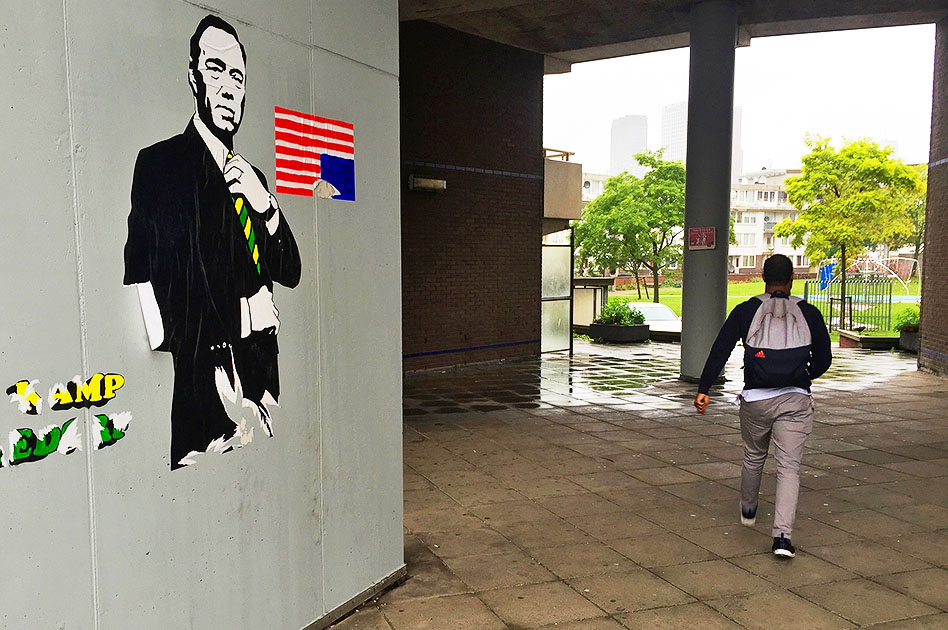Last week European media regulators revealed the latest in a long line of initiatives to keep Hollywood at bay. In a proposed amendment to its Audiovisual Media Services Directive, the European Commission announced a raft of measures to create “a more level playing field in the promotion of European works” – in other words, to get more EU-produced movies and TV shows onto its citizens’ smartphones, tablets and laptops.
Among the proposed initiatives is a European content quota for Netflix and other streaming services. Recognising that American tech firms will control a growing share of EU eyeballs in coming years – and noting the comparative advantage their “over-the-top” services have in relation to heavily regulated European broadcasters, which must comply with a raft of content and classification rules – the EC now proposes that the streaming giants “reserve at least 20 per cent share for European works in their catalogues.”
What’s more, the EC wants Netflix to give these titles significant prominence within the algorithmic recommendation system it uses to personalise content for each user. In other words, licensing a bunch of cheap Italian B-movies and burying them in the catalogue won’t cut it; the EC expects the mandated content to be as discoverable as the Hollywood hits. This would mean changes to the way Netflix’s algorithms work, given that content recommendation is tailored to an individual’s viewing history. As such, it would break new ground for local-content regulation.
Finally, the EC is also leaving open the option for member states to demand cash commitments by streaming services to national film and TV financing schemes, as a condition of doing business in those countries – in the same way that many European media broadcasters and cinema chains now contribute to national production funds.
These are major proposals, and it remains to be seen if all of them will be implemented. But the implications for media policy in other parts of the world are significant. Australians in particular should note these developments, given that many of the same concerns about local content and Hollywood domination in streaming services have been intensely debated here.
Let’s take a closer look at some of these issues, starting with the local content “problem.” Is there a local content deficit on Netflix? And if so, what can be done about it?
Writing on Netflix’s content strategy in 2012, when the service had just started rolling out to Europe and Latin America, Variety observed that “Netflix’s strength is still the Hollywood product that the whole world wants to see,” noting that the company’s general formula in overseas territories was “about 80 per cent American shows and 20 per cent local.”
Recent research confirms this trend. A 2015 European Audiovisual Observatory report, which focused on the origin of movies in Netflix’s European catalogues, concluded that “the average EU Netflix catalogue “has 1151 titles, of which 21 per cent are of EU origin and 6 per cent of national origin [local content].” The report notes variations from country to country: in Europe, Netflix France has a higher proportion of local films, whereas the British catalogue is the most Hollywood-centric.
Experts in Australia have also noted the low levels of local content in the Netflix catalogue. As Alexa Scarlata wrote in 2015, “A month into its service, Netflix had made thirty-four local films (mostly comedic) available in a specific ‘Australian Movies’ category (out of the 1047 films available), as well as a sub-genre of more than thirty ‘Australian TV Shows’ (out of the 317 television programs available).”
As these figures suggest, film and TV licensing have different dynamics. There is more Australian TV than cinema on Netflix, reflecting audiences’ historically higher preference for localism in TV content than in movies. But it’s important to note these are back-catalogue series licensed from the local networks. Unlike its local competitors Stan and Presto, Netflix has not commissioned any original Australian series.
This is a bone of contention for local screen industry groups including Screen Producers Australia, whose president, Matthew Deaner, yesterday released a statement in support of the European quota model:
These are big, disruptive, successful businesses that have had time to expand in the Australian market without making any significant investment in local production. It’s time they step up to the plate and contribute to new Australian film and television production…
[N]ow is the time to create a level regulatory playing field that ensures responsible and fair engagement from both local and businesses with our sector and Australian audiences.
The free-to-air networks are weighing into the debate as well. Sensing an opportunity to push a different agenda, Nine Entertainment’s Hugh Marks lost no time in pointing out that Netflix’s unfair advantage was evidence of the need to reduce local content commitments across the board:
I’m not in favour of additional content regulation on any platform… I’m in favour of less regulation.
Having said that, it would be nice to see some consistency in how various services are treated. Certainly, you’d want to ensure that these big SVOD [subscription video on-demand] players here are collecting GST and also paying the right corporate tax in Australia based on the profits they’re making out of this market.
As these statements indicate, industry arguments about local content often reflect stakeholder interests. All too often the “local content” argument becomes a foil for something else entirely: a debate about tax, or competition, or industry support, or subsidy.
(The same could be said for the other big item on the Australian cultural policy agenda in 2016 – removal of parallel import restrictions on books – which is similarly characterised by a perceived opposition between cultural-nationalist protectionism and free-market laissez-faire. I write perceived, because, as Emmett Stinson bravely suggests in Overland, the cultural claims of the parallel import argument are somewhat disconnected from the underlying political-economic issues in book trading.)
So, notwithstanding the stakeholder politics, the take-home point about Netflix is fairly clear. At present, Netflix is essentially a vehicle for distributing US content. Local content is a marginal aspect of its business model in Australia, as in most other territories. This may change over time as the company develops a deeper understanding of its global markets, but for the moment at least we should not expect that Netflix will behave otherwise. To do so would be to naively overestimate the value of “Australian content” to a company that has no real need to play that game at all.
Underlying the debate about Netflix’s commitment to Australian production is a deeper set of questions about local content itself – its definition, measurement and inherent value. These are all unresolved issues for cultural policy makers, and they loom like a spectre over our local content debates.
First, there are questions of definition. What do we actually mean by “local,” especially in a context where most Australian screen production is in some way, in terms of its style, aesthetics or production context (via co-productions, for example)? Screen Australia has an established formula for determining such matters, the Significant Australian Content test, but the outcomes are frequently contested.
A second issue relates to the utility of local content for audiences. As the European Commission’s new rules acknowledge, the mere presence of local content in schedules or services does not mean that it will necessarily be watched by audiences, so we have to consider usage and distribution as well when assessing local content availability.
Finally, there is a question about cultural value. The fact that content is local does not mean it will be valued as such by audiences, nor that it will resonate in the way intended by its producers or funding bodies (indeed, “foreign” content can often teach us more about the Australian experience than locally produced content). Local content does not automatically equal local cultural value.
Notwithstanding these important qualifications, there is broad consensus that local content quotas – as part of a larger package of policy measures – are desirable elements of media regulation in most nations. The political calculus of “Australian stories” and cultural nationalism in this sense acts as a natural counterweight for the deregulatory drive. So local content quotas will remain a feature of Australian media regulation for some time to come, and for very good reason.
The question facing policymakers now is about how and whether broadcast-era standards should be extrapolated to streaming services and video-on-demand sites, which have a completely different structure and geography from broadcast media. These issues have been considered before, notably in the 2012 Convergence Review (which proposed the new category of “Content Service Enterprise” as a workaround for this problem), and in academic work on media regulation. But they keep popping up again as new technologies and new platforms come online and present us with the same old questions about the fate of local content.
Netflix is merely the latest stage in this longer game.
A lot of the heat and light in this debate comes from the fact that we still haven’t figured out what kind of a media service Netflix is. Is it a broadcaster? If so, then the claims that it gets a free ride compared to local incumbents do make some sense. Or is it, as its CEO Reed Hastings claims, an “internet television network” – and what is the difference between these two things anyway?
In one sense, it all comes down to geography. Netflix is based firmly in Los Gatos, California; it operates in over 190 countries, and is committed to these markets for its future growth, but the nature of its business is such that it does not need to have much in the way of infrastructure or investment in those territories.
It operates at a distance, with everything controlled from its Californian headquarters. Like many new-economy companies, it provides a service to European and Australian consumers without necessarily being in those markets in the conventional sense (a legal grey-zone that tech giants are naturally adept at exploiting).
So, from the perspective of global media policy, the EC’s Netflix quota is a significant development. It confirms European regulators’ appetite for high-stakes stoushes with Silicon Valley (as also seen in recent tax and antitrust actions against Google and Apple). If implemented, the quota would open the way for a more interventionist approach to cultural regulation of digital services across Europe, and potentially elsewhere. And it would challenge the Silicon Valley doxa that local laws and cultural policy cannot simply be transposed verbatim onto the non-Euclidean territories of cyberspace without “breaking the internet.”
Anyway, these are all moot points given that EU-style content regulation for streaming services has been ruled out in Australia. This week communications minister Mitch Fifield has made it known that the government has no plans for changes to local content rules, certainly not in the middle of an election campaign.
So, no Netflix quota for the time being. But the complexities and contradictions of the local content debate will stay with us. •




